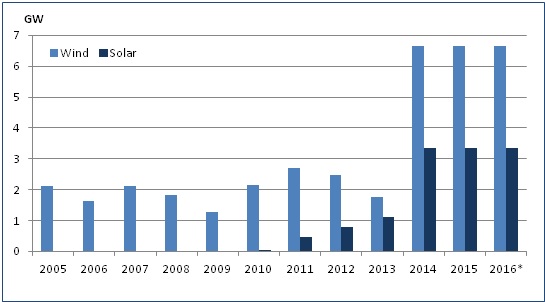India, the world's fifth largest wind power producer in 2013, has set up an ambitious plan to boost solar and wind capacities to contribute to meet the strong projected demand. The government aims to double its wind installed capacity by March 2017 (end of the 12th Plan) by adding 20 GW to its current capacity of 20.3 GW (at year-end 2013). In addition, India also targets to install 10 GW of solar capacity, i.e. almost fourfold its capacity at year-end 2013 (2,4 GW). This goal corresponds then to the commissioning of 6.7 GW/year of wind capacity and 3.3 GW/year of solar capacity on average by 2018. A longer-term objective is to connect 20 GW of solar capacity between 2010 and 2022 (Jawaharlal Nehru National Solar Mission). These targets look quite ambitious in view of the past achievements. This means more than a twofold increase in the new capacities installed every year. Indeed, over the eight past years, India has installed less than 2 GW/year of wind capacity on average, while the country has struggled to set up 1 GW/year of solar capacity in 2012 and 2013.
Trends in new wind and solar capacities installed every year

* April 2017 Source: Enerdata - Global Energy and CO2 Data
These goals will be achievable only with a strong support policy. India has introduced very attractive feed-in tariffs: between US$7.6c/kWh and US$11.6c/kWh for wind depending on the State, and between US$16.7c/kWh and US$20.7c/kWh for solar. Moreover, it has set up a mandatory share of renewable energy to be delivered by electricity suppliers under the Renewable Purchase Obligation scheme; 0.5% for solar and 9% for non-solar energy (namely, wind, mini hydro and biomass) of the power consumption in 2014. India has currently a large identified projects portfolio for wind and solar energies (more than 10 GW); among them the construction of four mega solar farms with a total capacity of more than 2 GW by next year and a 1 GW solar plant in the northwestern state of Rajasthan by 2017. This week, the first batch of projects under Phase-II of the National Solar Mission has been awarded, with the financial bids for 750 MW new photovoltaic capacities opened.
 Energy and Climate Databases
Energy and Climate Databases Market Analysis
Market Analysis